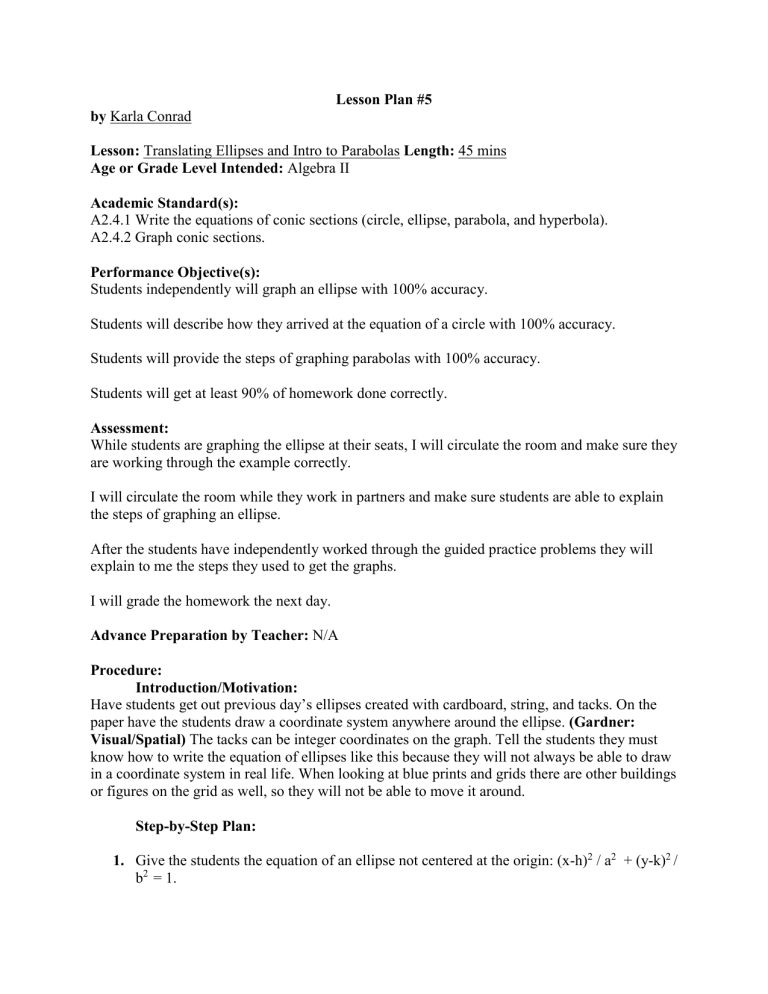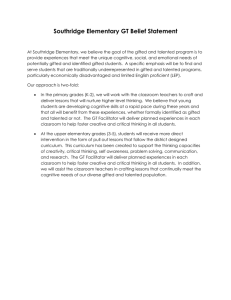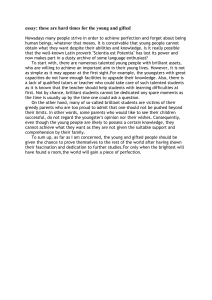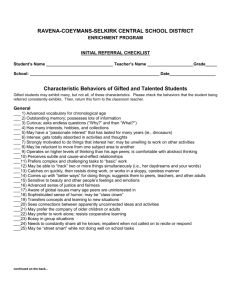Lesson Plan

Lesson Plan #5 by Karla Conrad
Lesson: Translating Ellipses and Intro to Parabolas Length: 45 mins
Age or Grade Level Intended: Algebra II
Academic Standard(s):
A2.4.1 Write the equations of conic sections (circle, ellipse, parabola, and hyperbola).
A2.4.2 Graph conic sections.
Performance Objective(s):
Students independently will graph an ellipse with 100% accuracy.
Students will describe how they arrived at the equation of a circle with 100% accuracy.
Students will provide the steps of graphing parabolas with 100% accuracy.
Students will get at least 90% of homework done correctly.
Assessment:
While students are graphing the ellipse at their seats, I will circulate the room and make sure they are working through the example correctly.
I will circulate the room while they work in partners and make sure students are able to explain the steps of graphing an ellipse.
After the students have independently worked through the guided practice problems they will explain to me the steps they used to get the graphs.
I will grade the homework the next day.
Advance Preparation by Teacher: N/A
Procedure:
Introduction/Motivation:
Have students get out previous day’s ellipses created with cardboard, string, and tacks. On the paper have the students draw a coordinate system anywhere around the ellipse. (Gardner:
Visual/Spatial) The tacks can be integer coordinates on the graph. Tell the students they must know how to write the equation of ellipses like this because they will not always be able to draw in a coordinate system in real life. When looking at blue prints and grids there are other buildings or figures on the grid as well, so they will not be able to move it around.
Step-by-Step Plan:
1.
Give the students the equation of an ellipse not centered at the origin: (x-h)
2
/ a
2
+ (y-k)
2
/ b
2
= 1.
2.
Have the students review their previous notes and give the midpoint formula that was discussed in the first lesson of this unit: (X
1
+X
2
) /2, (Y
1
+Y
2
)/2.
3.
With these two equations the students will be able to write the equations of their ellipses.
Have a student give you the coordinates of their ellipse. Walk them through the fact that the center of this ellipse is the midpoint between these coordinates.
4.
After getting the center ask the students where these numbers go in the equation. (They are the h,k.) (Blooms: Application)
5.
Have the students at their seats do number 7 on pg. 655. (graph (x+2)
2
/ 16 + (y-2)
2
/ 36
= 1. Circulate the room answering questions and making sure students are correctly graphing the ellipse. ( Gardner: Intrapersonal, Logical-Mathematical)
6.
Explain to the students they will now independently write the equations of their ellipse that is created on the cardboard. ( Gardner: Intrapersonal, Logical-Mathematical)
7.
After they have completed them tell them to find a partner and explain how they arrived at that equation. The students will correct each other if needed and use peer evaluation to help them understand the process. (Gardner: Interpersonal; Blooms: Comprehension,
Evaluation)
8.
Have the students go back to their seats and put away their ellipses.
9.
Tell them they are going to move onto the third conic section a parabola. Where do we see these shapes in real life? (Blooms: Knowledge) Recall in their notes what the general form is for a parabola. (X
2
= 4py, Y
2
= 4px)
10.
Present the definition of focus, directrix, and line of symmetry. (pg 620)
11.
Go through step by step example 1 on page 621. (Gardner: Verbal-Linguistic, Logical-
Mathematical)
12.
Have students do number 1 -2 of guided practice pg. 622. After completion ask the class to walk you through both of them. (Blooms: Comprehension)
13.
Assign ellipse and parabola homework: pg 655 10, 12,17,18 pg 623 3, 9, 10,15, 22,29-33 odd.
Closure:
Tomorrow we will explore the last conic section hyperbolas which can be seen to represent waves of various kinds as well as mirrors.
Adaptations/Enrichment:
There are a wide variety of gifted and talented students. Adaptations for some gifted and talented students might not be what another gifted and talented student needs. For examples a sequential learner will possible learn well in this lesson since the steps for ellipses and parabolas are followed. However, the spatial learner might become frustrated with the steps as they already see the big picture and do not need to do the whole process.
When the students are breaking up into partners to explain how they arrived at their equation there are some options that I have depending on the specific gifted and talented student.
If there is someone who is struggling with the material and there is a gifted and talented student who does not judge other students that struggle I might partner them together. The gifted and talented student then serves as a peer tutor for the other student. This would not work if the gifted and talented student exhibits rude behavior towards students who struggle. Then you
would just be setting the other person to feel embarrassed by this gifted and talented student. The other option would be to partner up two gifted and talented students and allow them to work together on a challenging story problem at this time. They have already had practice so would probably be bored with the activity everyone would be doing. This should be done discretely though so other students do not feel neglected.
When moving onto parabolas this will be the first time the students are presented with this material. However, I could have had the gifted students come by during study hall the previous day and introduce them to the new conic section. They could then work on story problems using this shape while the rest of the class does some more basic practice.
The homework assignment could also be adapted for the gifted and talented student. I would not add excess work to the assignment because that would be a punishment for the gifted and talented students. Instead I would leave one or two practice problems for them to do and then assign story problems or more challenging examples because they probably at this point would not need the extra practice to master the skill like the rest of the class would.
All of these kinds of differentiation could be worked into this whole unit. With conic sections there are many real world examples, but they are sometimes too hard for students to grasp. The regular students need lots of repetition and practice before they could move onto such problems, but the gifted and talented students would already have the basics down pat and would be ready for a challenge. I also have done a lot of group work with the rest of my lessons and could use the partner modifications in any of the lessons.
Self-Reflection: 1. Were the students able to use the midpoint formula?
2. Were the students able to explain to their classmates how they arrived at their equations?
3. Did the students have a lot of questions while working independently?
4. Did the students struggle with the guided practice?





